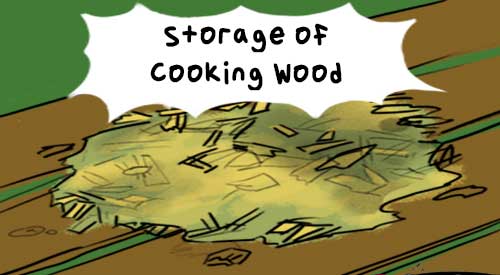 |
| As Fall approaches think about the storage of cooking wood. |
It seems every year as we approach the Fall, weather predictions are made on how severe the winter will be. This includes predictions on subzero cold in our area of the Northeast USA. In preparation for whatever Mother Nature brings our way, we thought this would be a good time to remind you about the storage and maintenance of your cooking wood products. Storage of wood is necessary to keep the flavor essence at its best which makes your foods taste great!
Wood and Water
As you have learned, wood is hygroscopic. That’s just a fancy word for saying wood can attract and absorb water. When you hot smoke, moisture is a friend to the wood because smoke is attracted to moist surfaces. To make sure your wood will produce a good quality smoke vapor, you need some water in the wood.
When wood “drinks” or takes in moisture, the molecules expand. Throughout the seasons, all hardwood will expand and contract as moisture and climate conditions change. Think temperature and humidity levels. Hot summers keep trees conserving water. Wet springs cause trees to swell and limit water intake.
What you may not know is some species of hardwood are more hygroscopic than others. This can bring some challenges at different times of the year and in various locations throughout North America. So,what can you do?
A Few Easy Tips for the Best Storage of Cooking Wood
Here are some suggestions to stabilize cooking hardwoods you may have purchased from us:
• purchase smaller quantities of wood that will meet your immediate cooking needs; a quantity you can use within a month’s time
• don’t store the wood directly on a concrete floor or in plastic containers. Hardwood will seek out the moisture found in concrete. Plastic containers can often make the wood sweat resulting in mold development
• try to maintain the hardwood in a storage location that has a temperature which doesn’t go above 55-60 degrees F. Relative humidity should be in the range of 40-50%
• for larger quantities of wood, try rotating or shaking the wood that is located at the bottom of the storage container to the top so you can ventilate the pieces equally
• if you should see signs of surface mold developing, mix 1 part vinegar (I prefer white) to 10 parts water and place in a spray bottle. Then spray the mixed solution on the wood pieces to halt and reverse any growth. For wood that is showing more severe mold, you can mix the same formula in a soaking bucket and place the pieces in the solution to soak for about an hour.
Select Hardwoods That Store Easier
A final point: denser hardwoods are more prone to instability because moisture variations can trigger more stress in these woods. To help understand what are the denser hardwoods, here is the order of our hardwoods from most dense to least: Hickory, Oak, Beech, Ash, Maple, Cherry, Alder.
With a little planning, you can continue to enjoy our premium cooking woods during all seasons of the year with little to no additional work. Don’t forget, Fall and Winter are two perfect seasons to fire up the grill and/or smoker and start experimenting with the seasonal foods available in your area!
شركة تنظيف منازل الجبيل
ReplyDeleteشركات غسيل السجاد
شركة مكافحة حشرات
شركة تعقيم منازل